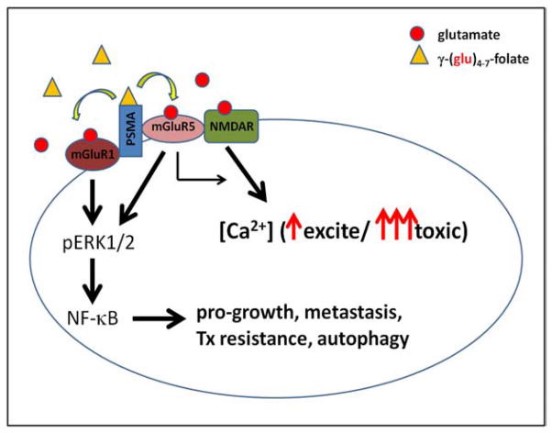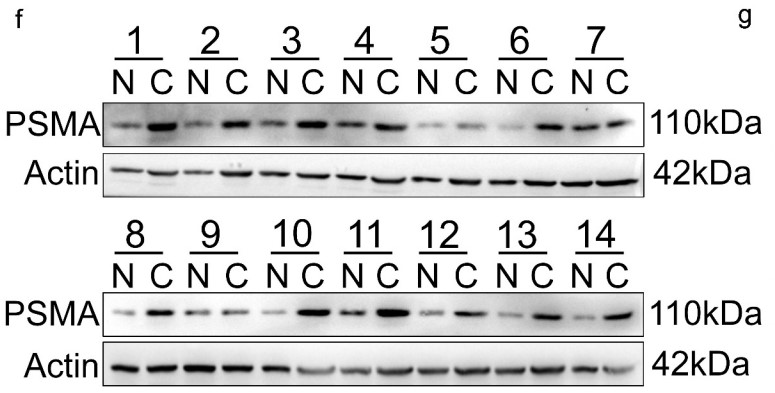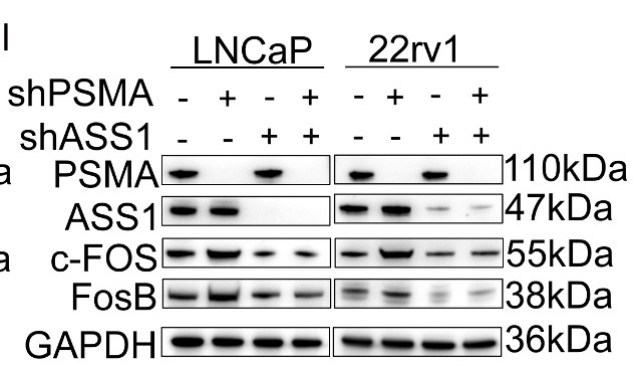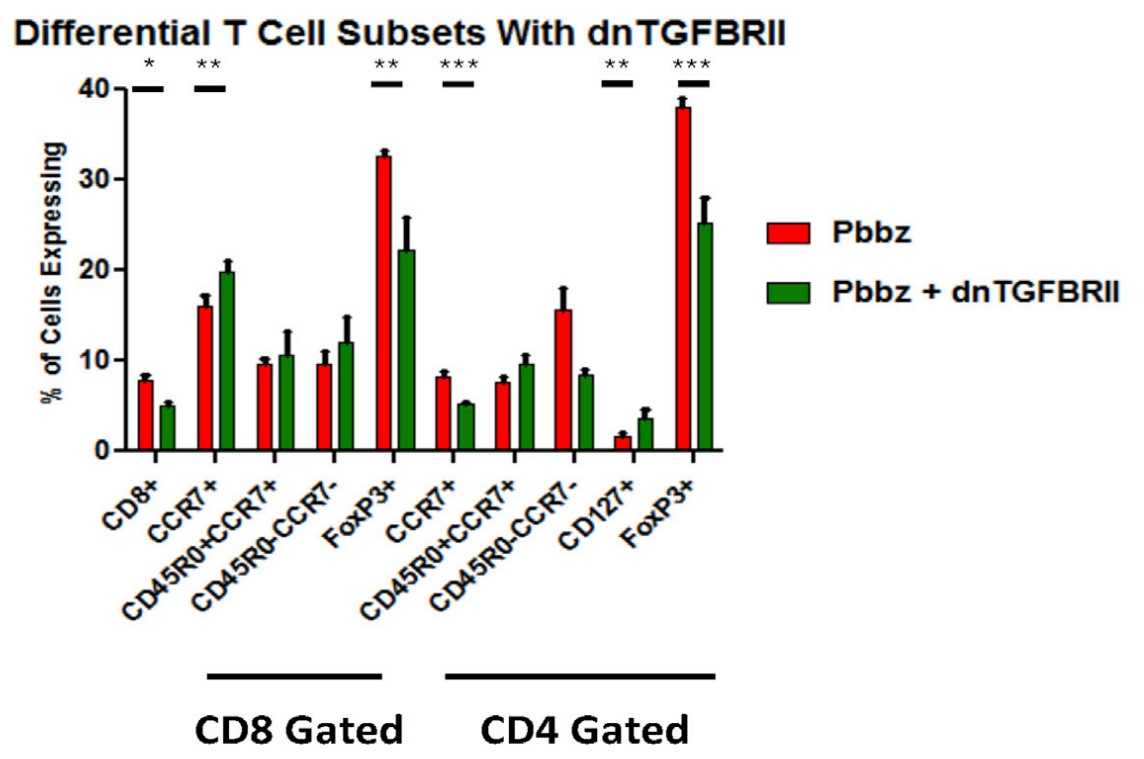FOLH1
-
Official Full Name
folate hydrolase (prostate-specific membrane antigen) 1 -
Overview
This gene encodes a type II transmembrane glycoprotein belonging to the M28 peptidase family. The protein acts as a glutamate carboxypeptidase on different alternative substrates, including the nutrient folate and the neuropeptide N-acetyl-l-aspartyl-l-glutamate and is expressed in a number of tissues such as prostate, central and peripheral nervous system and kidney. A mutation in this gene may be associated with impaired intestinal absorption of dietary folates, resulting in low blood folate levels and consequent hyperhomocysteinemia. Expression of this protein in the brain may be involved in a number of pathological conditions associated with glutamate excitotoxicity. In the prostate the protein is up-regulated in cancerous cells and is used as an effective diagnostic and prognostic indicator of prostate cancer. This gene likely arose from a duplication event of a nearby chromosomal region. Alternative splicing gives rise to multiple transcript variants encoding several different isoforms. [provided by RefSeq, Jul 2010] -
Synonyms
FOLH1;folate hydrolase (prostate-specific membrane antigen) 1;PSM;FGCP;FOLH;GCP2;PSMA;mGCP;GCPII;NAALAD1;NAALAdase;glutamate carboxypeptidase 2;NAALADase I;glutamate carboxylase II;glutamate carboxypeptidase II;membrane glutamate carboxypeptidase;cell growth-inhibiting gene 27 protein;folylpoly-gamma-glutamate carboxypeptidase;prostate specific membrane antigen variant F;pteroylpoly-gamma-glutamate carboxypeptidase;N-acetylated alpha-linked acidic dipeptidase 1;N-acetylated-alpha-linked acidic dipeptidase I
Recombinant Proteins
- Mouse
- Human
- Cynomolgus
- Rat
- Pig
- Sus scrofa (Pig)
- HEK293
- E.coli
- CHO
- Mammalian Cells
- Human Cells
- Insect Cells
- Wheat Germ
- In Vitro Cell Free System
- His
- Avi
- GST
- Non
- T7
- Flag
- Fc
- DDK
- Myc
- MBP
Background
What is FOLH1 protein?
FOLH1 (folate hydrolase 1) gene is a protein coding gene which situated on the short arm of chromosome 11 at locus 11p11. This gene encodes a type II transmembrane glycoprotein belonging to the M28 peptidase family. The protein acts as a glutamate carboxypeptidase on different alternative substrates, including the nutrient folate and the neuropeptide N-acetyl-l-aspartyl-l-glutamate and is expressed in a number of tissues such as prostate, central and peripheral nervous system and kidney. Expression of this protein in the brain may be involved in a number of pathological conditions associated with glutamate excitotoxicity. In the prostate the protein is up-regulated in cancerous cells and is used as an effective diagnostic and prognostic indicator of prostate cancer. This gene likely arose from a duplication event of a nearby chromosomal region. The FOLH1 protein is consisted of 750 amino acids and its molecular mass is approximately 84.3 kDa.
What is the function of FOLH1 protein?
It acts as a folate hydrolase, which is involved in the metabolism of folate, a B-vitamin that is essential for the synthesis of DNA and RNA and for cell division. FOLH1 also has N-acetylated-alpha-linked-acidic dipeptidase (NAALADase) activity, which is involved in the hydrolysis of the neuropeptide N-acetyl-L-aspartyl-L-glutamate (NAAG), thereby releasing glutamate. This process modulates excitatory neurotransmission in the brain. In the intestine, FOLH1 is required for the uptake of folate, indicating its role in the absorption of this essential nutrient. t is classified as a multifunctional enzyme with activities such as carboxypeptidase, dipeptidase, hydrolase, metalloprotease, and protease. FOLH1 has ligand binding properties, including binding to calcium and zinc, which are important for its enzymatic functions.

Fig1. Diagram of the possible consequences of PSMA folate hydrolase activity in prostate cancer cells. (C A Foss, 2012)
FOLH1 Related Signaling Pathway
In the brain, FOLH1 regulates excitatory neurotransmission by hydrolyzing the neuropeptide n-acetyl-L-aspartate-l-glutamate (NAAG) to release glutamate, which is associated with the glutamate signaling pathway. It has been suggested that FOLH1 may interact with the MAPK signaling pathway, which plays a key role in cell proliferation, differentiation and survival. FOLH1 may interact with folate receptors and participate in folate receptor-mediated signaling processes. FOLH1, as a folate hydrolase, plays a role in the metabolism of folate, an important factor in cell growth and DNA synthesis. FOLH1 activity may influence folic acid availability and related metabolic pathways.
FOLH1 Related Diseases
FOLH1 expression levels in prostate cancer are much higher than in normal prostate tissue, and it is overexpressed on the surface of more than 90% of prostate cancer cells. Because FOLH1 is involved in folic acid metabolism, its abnormal function may lead to folic acid malabsorption, which can lead to reduced blood folate levels and hyperhomocysteinemia, which is associated with cardiovascular disease. Folic acid is a key factor in the normal development of the embryonic neural tube, and variants in FOLH1 may affect folic acid utilization and are associated with an increased risk of neural tube defects. FOLH1 is also physiologically expressed in normal cells in a variety of organs, and due to its overexpression on cancer-associated neovascular structures, it has also been implicated in the imaging and treatment of other cancers such as bladder, pancreatic, lung, and renal cell carcinomas.
Bioapplications of FOLH1
Because FOLH1 is overexpressed on the surface of more than 90% of prostate cancer cells, it is used as a biomarker for prostate cancer. PSMA PET/CT scanning is an imaging technique using FOLH1 as a target for the early detection and staging of prostate cancer. FOLH1 has also been used as a target for antibody-mediated brachytherapy. For example, the J591 monoclonal antibody is a vector used in brachytherapy for FOLH1+ cancer, a method that involves placing a radioactive substance near the target tissue.
Case Study
Case Study 1: Xi Hong, 2022
The expression of prostate-specific membrane antigen (PSMA) is strikingly upregulated during oncogenesis and prostate cancer (PCa) progression, but the functions of this antigen in PCa remain unclear. Here, the researchers constructed PSMA-knockdown LNCaP and 22rv1 cell lines and performed metabonomic and transcriptomic analyses to determine the effects of PSMA on PCa metabolism and transcription. The metabolism of arginine and proline was detected using specific kits. The mRNA and protein expression levels of the identified differentially expressed genes were quantified by RT-qPCR and Western blotting. The proliferation of each cell line was evaluated through CCK-8, EdU and colony formation assays. The migration and invasion abilities of each cell line were detected using wound healing and transwell assays, respectively. PSMA knockdown led to metabolic disorder and abnormal transcription in PCa and resulted in inhibition of the proliferation and metastasis of PCa cells in vitro and in vivo. The depletion of PSMA also promoted the biosynthesis of arginine and proline, inhibited the expression of AR and PSA, and induced the expression of c-Fos and FosB.

Fig1. The expression of PSMA in PCa tissues was detected by Western blotting.

Fig2. After the knockdown of both PSMA and ASS1, kits were used to detect the concentrations of arginine and proline.
Case Study 2: Christopher C Kloss , 2018
Cancer has an impressive ability to evolve multiple processes to evade therapies. While immunotherapies and vaccines have shown great promise, particularly in certain solid tumors such as prostate cancer, they have been met with resistance from tumors that use a multitude of mechanisms of immunosuppression to limit effectiveness. Prostate cancer, in particular, secretes transforming growth factor β (TGF-β) as a means to inhibit immunity while allowing for cancer progression. Blocking TGF-β signaling in T cells increases their ability to infiltrate, proliferate, and mediate antitumor responses in prostate cancer models. We tested whether the potency of chimeric antigen receptor (CAR) T cells directed to prostate-specific membrane antigen (PSMA) could be enhanced by the co-expression of a dominant-negative TGF-βRII (dnTGF-βRII). Upon expression of the dominant-negative TGF-βRII in CAR T cells, the researchers observed increased proliferation of these lymphocytes, enhanced cytokine secretion, resistance to exhaustion, long-term in vivo persistence, and the induction of tumor eradication in aggressive human prostate cancer mouse models.

Fig3. T cells expressing Pbbz specifically lyse PSMA-PC3 cells in 24-hr luciferase-based lysis assays.

Fig4. T cells were analyzed with flow cytometry at day 21 post co-culture of Pbbz or dnTGF-βRII-T2A-Pbbz CAR T cells.
Quality Guarantee
Involved Pathway
FOLH1 involved in several pathways and played different roles in them. We selected most pathways FOLH1 participated on our site, such as Alanine, aspartate and glutamate metabolism,Metabolic pathways,Vitamin digestion and absorption, which may be useful for your reference. Also, other proteins which involved in the same pathway with FOLH1 were listed below. Creative BioMart supplied nearly all the proteins listed, you can search them on our site.
| Pathway Name | Pathway Related Protein |
|---|---|
| Vitamin digestion and absorption | PNLIP,MMACHC,SLC5A6,APOA4,RBP2,BTD,CUBN,APOB,SLC46A1,ABCC1 |
| Alanine, aspartate and glutamate metabolism | GLUD1A,GFPT2,RIMKLB,GPT2,GLULB,ASS1,IL4I1,GFPT1,GLUL,ABAT |
| Metabolic pathways | ACSBG2,ACSS2L,GALNT11,GCDHA,FUK,DNMT3A,GALNTL2,EARS2,B3GNTL2,PDHA1A |
Protein Function
FOLH1 has several biochemical functions, for example, Ac-Asp-Glu binding,dipeptidase activity,metal ion binding. Some of the functions are cooperated with other proteins, some of the functions could acted by FOLH1 itself. We selected most functions FOLH1 had, and list some proteins which have the same functions with FOLH1. You can find most of the proteins on our site.
| Function | Related Protein |
|---|---|
| peptidase activity | GZMF,MMP23BB,USP27X,NAPSA,BMP1B,KLK1B22,HTRA1B,TMPRSS11F,CAPN3B,AGBL1 |
| dipeptidase activity | SCRN2,CNDP2,PEPD,DPEP3,SCRN3,SCRN1,CNDP1,NAALADL1,NAALAD2,DPEP2 |
| metal ion binding | ZSCAN21,KALRN,UNC13A,ARFGAP1,SNRNP48,PVALB8,CLCA1,MYLK,LHX8,TRMT13 |
| metallocarboxypeptidase activity | CPO,CPA1,AGBL3,PEPD,CPA5,CPA6,CPM,AEBP1,AGBL1,AGTPBP1 |
Interacting Protein
FOLH1 has direct interactions with proteins and molecules. Those interactions were detected by several methods such as yeast two hybrid, co-IP, pull-down and so on. We selected proteins and molecules interacted with FOLH1 here. Most of them are supplied by our site. Hope this information will be useful for your research of FOLH1.
Dlg4;RPS3;MTAP;MME
Resources
Research Area
Related Services
Related Products
References
- Haffner, MC; Laimer, J; et al. High expression of prostate-specific membrane antigen in the tumor-associated neo-vasculature is associated with worse prognosis in squamous cell carcinoma of the oral cavity. MODERN PATHOLOGY 25:1079-1085(2012).
- Haffner, MC; Kronberger, IE; et al. Prostate-specific membrane antigen expression in the neovasculature of gastric and colorectal cancers. HUMAN PATHOLOGY 40:1754-1761(2009).


.jpg)
.jpg)

